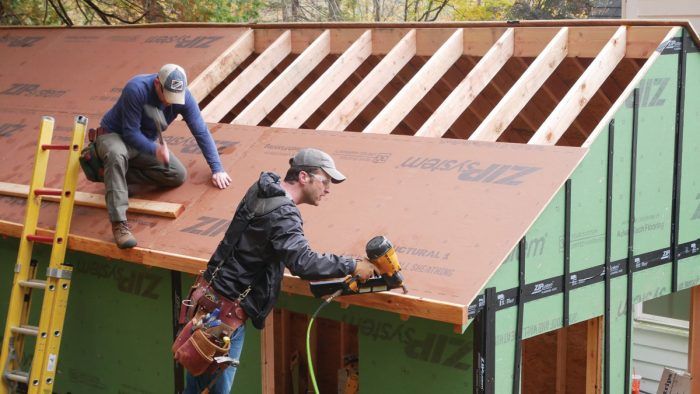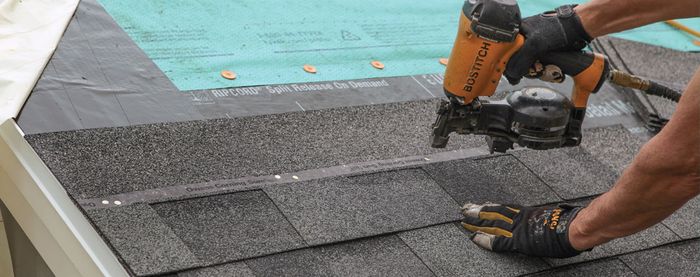Chasing Wind-Load Requirements
New research has resulted in a better understanding of how wind pressure acts on roofs.

The International Residential Code (IRC) does have its share of mandatory provisions, such as heating, fall protection, and emergency escape (to name a few), that cannot be engineered around. But most of what’s in the code is really a gift—a slew of free, pre-engineered and preapproved design methods based on common construction materials. One element that guides these provisions, especially those in Chapters 4 through 9, is nature. Before it gets into construction materials and methods, the IRC provides data about the forces of nature you’ll have to contend with when building in North America. This data is indispensable for designing a safe, durable home.
This data lives with the mandatory provisions in Chapter 3 (Building Planning), right at the top in section R301, which provides, in maps and tables, the climatic and geographic variables that dictate the load-resisting requirements for structures in all regions of the U.S.
Essentially, it tells you the loads you are required to resist. It’s up to the designer to decide the materials and methods they want to use and a means to prove they meet or exceed the loads. One such method is using the prescriptive design provisions in the IRC.
These provisions aren’t static. The load requirements in R301 sometimes change because, for a variety of reasons, climatic and geographic variables fluctuate over time. When these continually evaluated forces of nature change, the loads on buildings change, and building codes change to enable new structures to withstand them. These changes are reflected not just in the mandatory loads in R301; the code’s prescriptive design provisions must also be updated. This can take some time, as it takes additional analysis, design, and testing to, for example, figure out how many nails of a particular size are needed to keep sheathing attached to roofs of different heights, slopes, and geographic exposures during high-wind events. In the case of the updated wind loads in the 2021 IRC, it took nearly a decade.
The IRC’s mandatory load requirements are derived from ASCE 7, the most respected and referenced standard for minimum design loads of buildings, developed by the American Society of Civil Engineers. This standard is periodically updated, though at a different frequency than the IRC. The last two revisions have seen substantial changes to the wind-load provisions. New research resulted in a better understanding of how wind pressure acts on roofs in areas with 115-mph-or-greater winds, as well as which areas of roofs are most susceptible to wind. Previous editions identified that the roof area within B. of gable ends was at risk, but the 2016 version of ASCE 7 lists ridges, hips, and eave edges, as well as the corners where they meet, as being more prone to damage.
Finally, the 2021 IRC incorporates all the new wind design data from ASCE 7. As mentioned earlier, the IRC had to be updated in two places to incorporate the new ASCE 7 loads. The first change is to the design criteria in Chapter 3, the mandatory provisions. In the new wind maps, the lowest-speed wind zone, which covers a large portion of the west coast, has dropped from 110 mph to 90 mph, with speeds gradually increasing toward the center of the country. Table R301.2.1(1) (previously Table R301.2(2)), which provides the wind pressures on roof surfaces and wall cladding, also changed significantly to include columns with lower pressures that reflect the reduced wind-speed zones. Remember, regardless of the material or method of construction, this table provides the actual pressure acting on roof sheathing and coverings under many different variables. The table is based on a 30-ft. roof height in exposure B (urban and suburban areas), but the values there can be adjusted for other scenarios using Table R301.2(3), which has coefficients derived for different roof heights and wind exposures.
With the changes to R301 established, the methods and materials provided in the IRC also needed to be modified Here, the IRC uses engineering procedures developed by the American Wood Council (AWC), which used the ASCE 7 loads to find sufficient wood materials and fastening to satisfy them. The engineers at the AWC assume the most likely variables in order to produce simplified design methods and tables that allow limited residential construction without a design professional. This allows the IRC to provide us simplified instructions for common installation.
All of this has resulted in the one big change you will likely notice in the 2021 IRC, to the minimum required nailing of 3⁄8-in. to 1⁄2-in. wood structural panel roof sheathing, which is found in Table R602.3(1). For decades, the norm has been to nail sheathing with 6-in. spacing on the edges and 12-in. spacing in the field (or, as the code refers to it, “intermediate supports”). This has been reduced to 6-in. spacing both on the edges and in the field. While that kind of nailing may be overkill where winds are weak, the change is intended to provide a simple prescriptive solution to a large swath of the country, specifically areas with wind speeds under 140 mph (areas with wind speeds equal to or greater than 140 mph can’t use the IRC for wind design, but the IRC does list, in section R301.2.1.1, a number of alternative publications that can provide guidance). This limitation simplifies the design variables to reduce the complexity of the IRC’s prescriptive design.
The tightened fastening pattern is based on 24-in.-on-center rafters, common species of wood, and up to a 140-mph wind speed. Footnote f in the fastening schedule table provides some additional variables that can’t be overlooked. On portions of roofs where wind pressures are highest, additional fastening is required in some instances. However, as prescriptive design methods do, the IRC simplifies the guidance by designing to the roof zone with the greatest pressure. For geographical regions with wind speeds greater than 130 mph in exposure B or greater than 110 mph in exposure C (flat, open country and grasslands), nails within 48 in. of roof edges and ridges must be no farther than 4 in. apart at panel edges and intermediate supports.
If that all seems like too much nailing, there are other options. You could use Table R301.2.1(1) and get the exact wind pressures on the sheathing in the different roof zones. As mentioned previously, it provides for reduced wind speeds down to 90 mph, along with different values for roof pitch, area, height, and wind exposure—all variables that are assumed in the prescriptive design. You can use this to get your exact target loads and hire a design professional to come up with a solution that allows you to use fewer nails than the 2021 IRC requires. It is your choice.
Another option is using the Wood Frame Construction Manual by the AWC. This manual is a direct reference from the IRC for wood construction (R301.1.1), and it includes more extensive prescriptive (pre-engineered) design tables than the IRC. This book can be viewed for free online at AWC.org/codes-standards. In this reference you will find that at 120 mph or less, you’re right back to that familiar 6-in. and 12-in. spacing. If your rafters are spaced any closer than 24 in., you’re also good at the old 6-in. and 12-in. spacing in areas with winds up to 140 mph.
It is a choice we make, perhaps without realizing it, to use the simplified and free prescriptive design methods contained within the IRC. This optional design method won’t be perfectly minimal for your structure, but it’s likely an easier choice to just add the extra sheathing nails.
Glenn Mathewson is a consultant and educator with BuildingCodeCollege.com.
From Fine Homebuilding #305
RELATED LINKS





